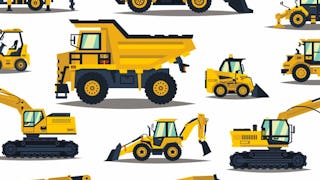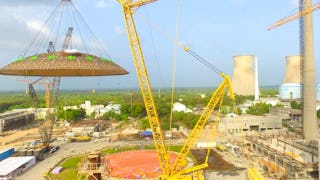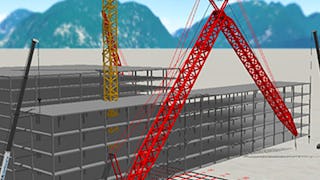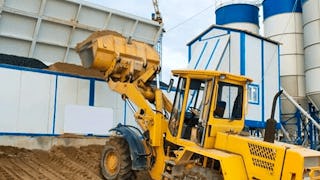This course covers the evolution and application of heavy lifting techniques across various sectors. It starts with an introduction to the significance and engineering concepts of heavy lifts, detailing advanced machinery and sector-specific applications. Fundamental concepts of force handling, including horizontal and vertical movements, forces and equilibrium, and load estimation, are explored through case studies. The course delves into friction mechanics, mechanical advantage, reeving, and the lever principle, providing essential knowledge for load management. It introduces lifting gears, covering shackles, wire rope slings, and spreaders, and explores hydraulic systems, various jacks, and strand jacks. Real-world applications, including the installation of sky bridges and other heavy lifting scenarios, are examined to highlight the practical utility of these advanced technologies.

Enjoy unlimited growth with a year of Coursera Plus for $199 (regularly $399). Save now.

Concepts of Heavy Lifting
This course is part of Strategies for Heavy Lifting Specialization

Instructor: Subject Matter Expert
Included with
Recommended experience
What you'll learn
Learn the evolution, engineering principles, and applications of heavy lifting machinery in power, hydrocarbon, and construction industries.
Master force handling, friction mechanics, and load estimation with practical case studies and real-world scenarios like sky bridge installations.
Become proficient in using shackles, slings, spreaders, hydraulic systems, and jacks for efficient and safe heavy lifting operations.
Skills you'll gain
Details to know

Add to your LinkedIn profile
5 assignments
See how employees at top companies are mastering in-demand skills

Build your subject-matter expertise
- Learn new concepts from industry experts
- Gain a foundational understanding of a subject or tool
- Develop job-relevant skills with hands-on projects
- Earn a shareable career certificate

There are 5 modules in this course
This course module explores the evolution of heavy lifts, beginning with an introduction to their significance and the basic engineering concepts behind them. The module is divided into two parts, detailing these engineering applications. It then examines the machinery required for advanced lifting methods. The course further delves into sector-specific applications: heavy lifting in the power sector, hydrocarbon industry, power transmission and distribution, and the building and material handling sector. Additionally, it covers the role of heavy lifting in water and effluent treatment, as well as in the installation of statues, highlighting the broad utility of advanced lifting technologies.
What's included
11 videos1 assignment
This course module introduces the fundamental concepts of handling forces, focusing on both horizontal and vertical movements. It delves into the principles of forces and equilibrium, illustrated through case studies on the composition of forces and three-dimensional force systems. The module covers moments and couples, emphasizing their role in engineering mechanics. Additionally, it highlights the importance of accurate load estimation and understanding the center of gravity. A dedicated case study on the center of gravity further reinforces these concepts, providing practical insights and applications essential for mastering the complexities of force management in various engineering contexts.
What's included
9 videos1 assignment
This course module explores the fundamental concepts of sliding and rolling friction, providing a comprehensive understanding of their roles in mechanical systems. It delves into mechanical advantage in lifting and shifting systems, particularly focusing on reeving and its applications. The module also covers the lever principle, essential for understanding load distribution and manipulation. Additionally, it provides detailed guidance on calculating forces on load handling elements, split into two parts for thorough exploration. By the end of the course, learners will gain an understanding in friction mechanics and load management, crucial for efficient and safe handling operations in various engineering fields.
What's included
8 videos1 assignment
This course module provides a comprehensive introduction to lifting gears and essential components used in rigging and lifting operations. It begins with an overview of shackles, exploring their types and applications. The module then covers wire rope slings in two parts, detailing their construction, configurations, and diverse applications across industries. Additionally, it delves into the specialized equipment of spreaders and lifting beams, discussing their design principles, functionalities, and practical applications through two comprehensive sections. By the end of the module, learners will have acquired fundamental knowledge and skills necessary for the safe and effective use of lifting gears in various lifting and rigging scenarios.
What's included
8 videos1 assignment
This course module covers hydraulic systems and their basic components, providing a fundamental understanding essential for advanced applications. It explores various types of jacks and their specific applications, including special types used in unique lifting scenarios. The module introduces the principles of strand jacks, detailing their control systems and the advantages of computerized control. It further examines the application of strand jacks in lifting and installing sky bridges, showcasing their precision and reliability. Finally, it discusses real-world applications of strand jacks in heavy lifting contexts, highlighting their efficiency and versatility in modern engineering projects requiring precise and controlled lifting operations.
What's included
10 videos1 assignment
Earn a career certificate
Add this credential to your LinkedIn profile, resume, or CV. Share it on social media and in your performance review.
Instructor

Offered by
Explore more from Environmental Science and Sustainability
 Status: Free Trial
Status: Free TrialL&T EduTech
 Status: Free Trial
Status: Free TrialL&T EduTech
 Status: Free Trial
Status: Free TrialL&T EduTech
 Status: Free Trial
Status: Free TrialL&T EduTech
Why people choose Coursera for their career




Frequently asked questions
To access the course materials, assignments and to earn a Certificate, you will need to purchase the Certificate experience when you enroll in a course. You can try a Free Trial instead, or apply for Financial Aid. The course may offer 'Full Course, No Certificate' instead. This option lets you see all course materials, submit required assessments, and get a final grade. This also means that you will not be able to purchase a Certificate experience.
When you enroll in the course, you get access to all of the courses in the Specialization, and you earn a certificate when you complete the work. Your electronic Certificate will be added to your Accomplishments page - from there, you can print your Certificate or add it to your LinkedIn profile.
Yes. In select learning programs, you can apply for financial aid or a scholarship if you can’t afford the enrollment fee. If fin aid or scholarship is available for your learning program selection, you’ll find a link to apply on the description page.
More questions
Financial aid available,





